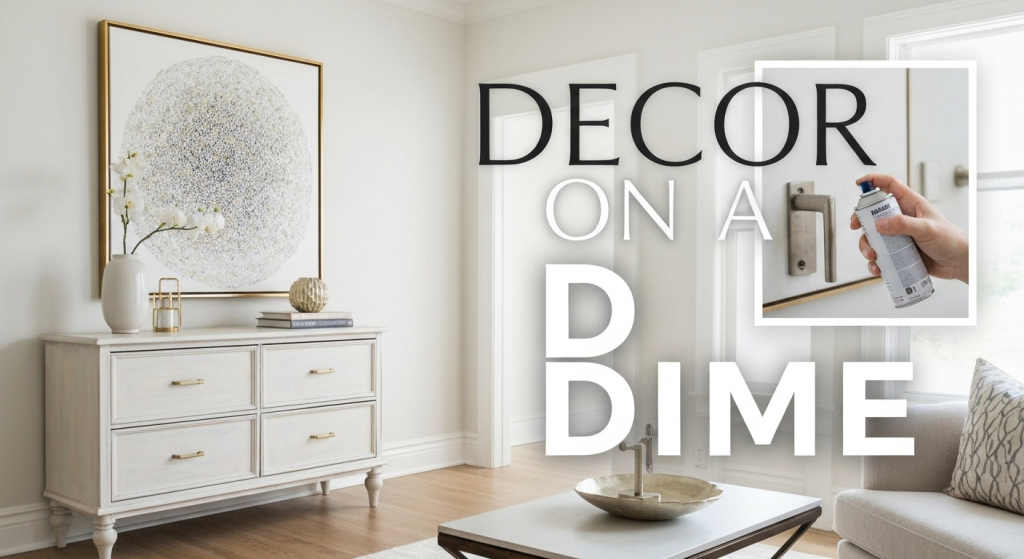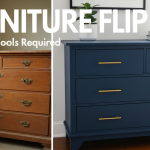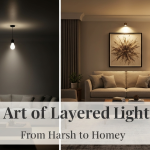Ever scroll through a pristine home decor feed and feel that familiar pang? It’s a mix of pure inspiration and, let’s be honest, budget dread. You want that polished, sophisticated look—the kind that feels calm, collected, and intentionally designed. But the price tags on designer furniture and high-end accessories can feel like a world away. Here’s the good news: creating an expensive-looking home has far less to do with how much you spend and much more to do with how you think about decor. It’s about clever tricks, a good eye, and a little bit of DIY magic.
For the past several years, I’ve been fascinated by this very puzzle: how to bridge the gap between our design dreams and our financial reality. This curiosity has led me down countless aisles of thrift stores, deep into the history of design principles, and through many weekends of hands-on projects. My goal has always been to understand the ‘why’ behind what makes a space feel luxurious. Now, I love sharing those discoveries, breaking down complex ideas into simple, actionable steps that anyone can use. It’s not about gatekeeping design secrets; it’s about empowering you to create a home you truly love, regardless of your budget.
Let’s dive into the practical strategies that will transform your space from budget-basic to beautifully bespoke.
The Foundation: A Mindset for High-End Style
Before you pick up a paintbrush or add anything to a shopping cart, the most significant change starts with your approach. High-end design isn’t about owning the most expensive items; it’s about a thoughtful and curated environment. Adopting this mindset is the first and most crucial step.
Think Curation, Not Collection
A common mistake when decorating on a budget is accumulating lots of small, inexpensive items to fill space. This often leads to a cluttered, disjointed look that feels the opposite of luxurious. A high-end aesthetic is built on restraint and intention.
Here’s what this really means:
- Be Patient: Don’t rush to fill every empty corner. An empty space looks better than a space filled with something you don’t love. Wait until you find the right piece.
- Follow the “One In, One Out” Rule: When you bring a new decor item home, challenge yourself to let go of an old one. This prevents clutter from building up and forces you to be selective about what you keep.
- Focus on Impact: Instead of buying five small, generic vases, save that money for one larger, more interesting piece that can serve as a focal point.
In my own first apartment, I made the classic mistake of buying dozens of little knick-knacks from discount stores. The surfaces were full, but the room had no personality. It wasn’t until I cleared everything away and slowly reintroduced a few meaningful, larger-scale items that the space started to feel sophisticated.
Master Scale and Proportion
One of the quickest ways to spot an amateurishly designed room is through poor scale. “Scale” refers to how the size of an object relates to the size of the room and the other objects within it. Getting this right is a free way to make your entire home look more professional.
- The Rug Rule: A small rug floating in the middle of a large room screams “budget.” Your area rug should be large enough that at least the front legs of all major furniture pieces (sofa, chairs) are sitting on it. This grounds the space and makes it feel larger and more cohesive.
- Art at the Right Height: Art should be hung so that its center is at eye level, which is typically around 57-60 inches from the floor. Hanging art too high disconnects it from the furniture below and disrupts the flow of the room.
- Furniture Fit: Avoid pushing all your furniture against the walls. Even pulling your sofa a few inches away from the wall can create a sense of breathing room and make the layout feel more intentional and high-end.
The Magic of a Makeover: Upgrading What You Already Have
Some of the most impactful transformations don’t require buying anything new. They involve giving a little love and a clever disguise to the affordable items you find at thrift stores, flea markets, or even big-box retailers.
A Can of Spray Paint is Your Best Friend
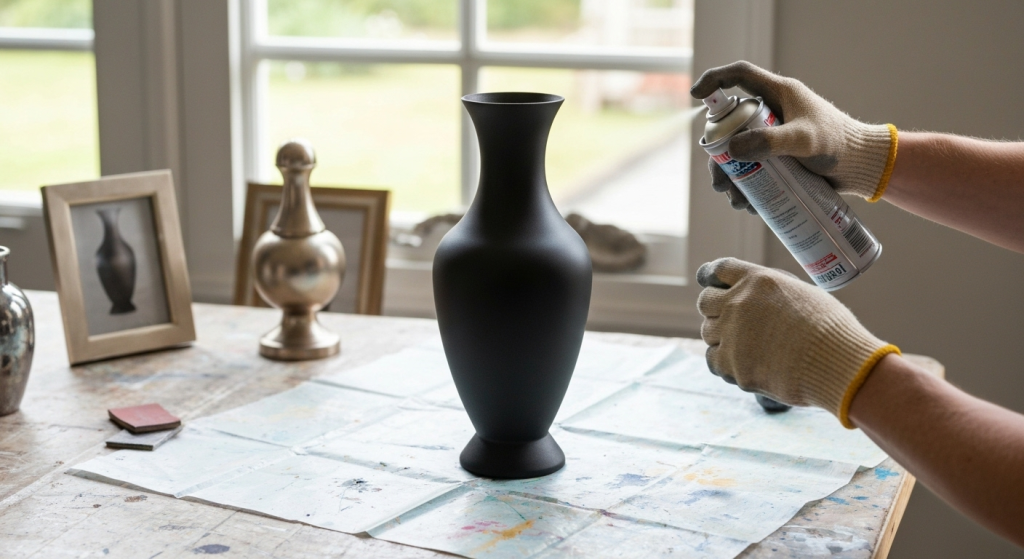
Never underestimate the transformative power of paint. A can of high-quality spray paint can turn a cheap plastic item into something that looks like aged brass, matte ceramic, or sleek metal. It’s the ultimate budget decor hack.
Let’s break down how to do it right, because preparation is everything:
- Clean Your Item: Use a degreasing cleaner to remove any dust, oils, or residue.
- Lightly Sand: For plastic or glossy surfaces, a quick pass with fine-grit sandpaper (around 220-grit) gives the paint something to grip onto. You’re not trying to remove the finish, just “scuff” it up.
- Use a Primer: This is the step most people skip, and it’s the most important for a lasting, professional finish. Use a spray primer designed for the material you’re painting (e.g., plastic primer).
- Apply Light Coats: Hold the can about 8-12 inches away and use sweeping, steady motions. It’s much better to apply 2-3 very thin coats than one thick, drippy coat. Let it dry completely between coats.
I once found a set of horribly dated, shiny gold plastic lamps at a garage sale for $5. A coat of matte black spray paint on the bases instantly made them look like something from a modern design store.
| Paint Finish | Best For Creating a… | Common Uses |
| Matte/Chalky | Modern, “earthenware” or ceramic look. | Vases, decorative bowls, lamp bases. |
| Satin/Eggshell | Subtle, sophisticated sheen. Hides imperfections. | Furniture, picture frames, light fixtures. |
| Metallic (Gold, Brass) | Glamorous, expensive feel. | Drawer pulls, decorative objects, mirror frames. |
| High-Gloss | Bold, lacquered, high-energy look. | Statement furniture pieces, trays. |
Swap Out the Hardware: The Easiest Furniture Facelift
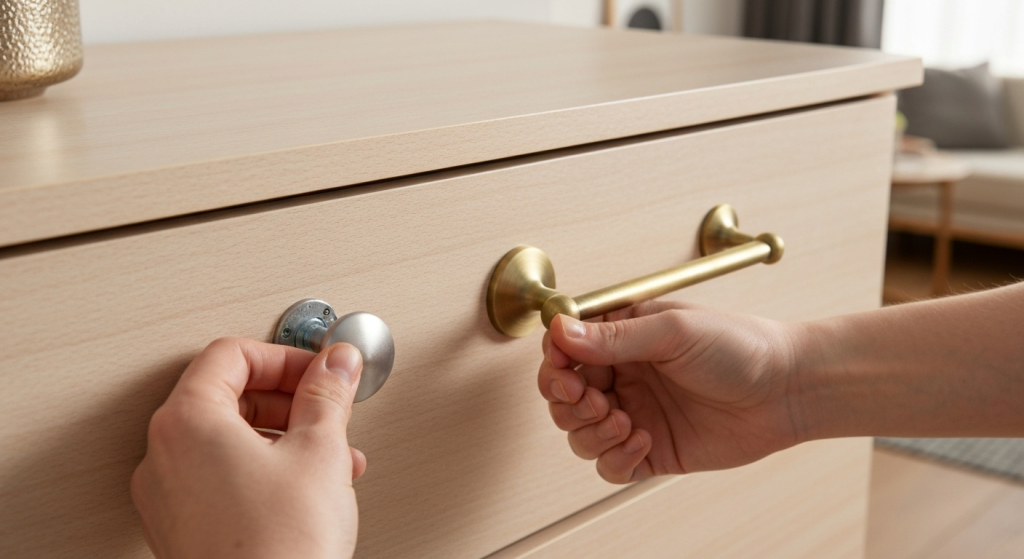
Standard-issue hardware on budget furniture (like dressers, cabinets, and nightstands) is often a dead giveaway of its low cost. Replacing these generic knobs and pulls is a simple, five-minute job that yields an incredible return on investment.
You can find beautiful, inexpensive hardware online (think Amazon, Etsy) or at craft stores and home improvement centers. Look for solid-feeling pieces in timeless finishes like brushed brass, matte black, or polished nickel. This single change can elevate a basic IKEA dresser into a piece that looks like it came from a high-end boutique.
| Pros of Swapping Hardware | Cons of Swapping Hardware |
| High Impact, Low Effort: Drastically changes the look of furniture in minutes. | Measurement is Key: You must match the distance between screw holes on pulls. |
| Affordable: A new set of knobs can cost as little as $10-$20. | Potential for Mismatched Holes: You may need to fill old holes if you switch from a pull to a knob. |
| Completely Reversible: Perfect for renters or if you change your mind later. |
Creating Visual Impact: Tricks for Walls and Windows
The largest surfaces in your room—the walls and windows—have a massive impact on how expensive and “finished” the space feels. Get these right, and you’ve won half the battle.
Go Big with Art (Without the Big Price Tag)
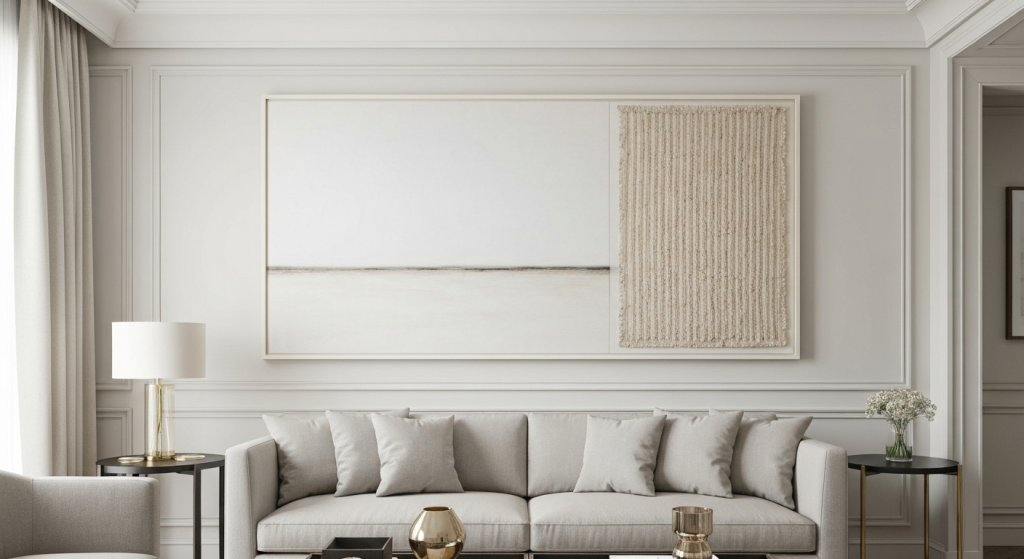
A common decorating pitfall is using art that is too small for the wall. A tiny, lonely frame above a large sofa looks awkward and cheap. Large-scale art, on the other hand, makes a confident statement and feels luxurious and intentional.
But large art doesn’t have to mean a large expense. Here’s how to fake it:
- Digital Downloads: Websites like Etsy are full of artists selling high-resolution digital art files for just a few dollars. You can then have them printed at a local print shop or an online service in a large format (like 24×36 inches) for a fraction of the cost of a pre-framed piece.
- Frame a Fabric Remnant: Find a beautiful piece of fabric—a scarf, a textile remnant—with a large-scale pattern. Stretch it over a blank canvas or place it in a large frame for instant, textured art.
- Thrift Store Frames: Keep an eye out for huge, ugly art at thrift stores. Often, the frame is worth more than the art itself. You can discard the dated print and use the high-quality frame for your own large print. I found a massive, ornate gold frame for $15, painted it matte black, and used it to frame an engineering print of a family photo. It’s now the centerpiece of our hallway.
The Drapery Deception: Curtains That Look Custom-Made
Nothing cheapens a room faster than ill-fitting curtains. Short, narrow drapes that barely cover the window look like an afterthought. The goal is to create the illusion of height and width, making your windows (and your whole room) feel grander.
Follow these two golden rules for hanging curtains:
- Hang Them High: Mount the curtain rod 4-6 inches above the window frame. This draws the eye upward and creates the illusion of a taller ceiling.
- Hang Them Wide: Extend the rod 3-6 inches beyond the window frame on each side. When the curtains are open, they will rest against the wall, not block the glass, making the window appear wider and allowing maximum natural light to enter.
When it comes to the curtains themselves, look for materials that have some weight and texture, like linen blends, cotton canvas, or even faux velvet. These hang better and look much more expensive than thin, sheer polyester. You can often find great options at stores like IKEA, Target, or HomeGoods.
Mastering the Details: Small Touches, Big Difference
Luxury is often found in the details. Once the large pieces are in place, it’s the final layers of styling that truly elevate the look and feel of your home.
Textiles Are Your Secret Weapon
Texture adds depth, warmth, and a tactile sense of luxury to a space. Layering different textiles is one of the easiest ways to make a room feel cozy and professionally styled.
- Pillows: Ditch the flat, lifeless pillows that often come with a sofa. Instead, buy pillow covers separately and invest in high-quality feather or down inserts that are one size larger than the cover (e.g., a 20×20 inch insert for an 18×18 inch cover). This makes them look plump, full, and incredibly inviting.
- Throws: A chunky knit or soft faux-fur throw blanket draped casually over an armchair or the corner of a sofa adds instant coziness and a touch of effortless style.
- Rugs: Even if you have carpet, layering a smaller, textured rug on top can define a seating area and add another layer of visual interest.
The Power of Greenery (Real or Faux)
Plants and flowers breathe life into a room. They add an organic element, a pop of color, and a sense of vitality that makes a space feel fresh and cared for. If you don’t have a green thumb, don’t worry. Today’s faux plants are incredibly realistic.
The key to making both real and faux plants look high-end is the vessel they’re in. Ditch the cheap plastic nursery pot. Repot your plants into something more substantial and stylish, like a ceramic planter, a woven basket, or a rustic terracotta pot. This simple swap makes a world of difference.
Declutter and Style with Intention
Clutter is the enemy of a high-end look. Luxury spaces feel calm and organized, not chaotic and busy. This doesn’t mean you have to become a minimalist, but it does mean that everything on display should be there for a reason.
Instead of scattering objects around, group them into “vignettes.” A vignette is simply a small, curated arrangement of items on a surface like a coffee table, bookshelf, or console table.
- Use the Rule of Threes: Group items in odd numbers, particularly threes. Our brains find this visually more appealing and balanced than even-numbered groupings.
- Vary Height and Texture: In your group of three, include something tall (like a vase with branches), something low and horizontal (like a stack of books), and a sculptural object (like a decorative bowl or knot).
- Use Trays: A simple tray is a stylist’s best friend. It corrals smaller items (like remotes, coasters, and a candle) on a coffee table, making them look like a deliberate arrangement instead of random clutter.
Smart Shopping for High-End Finds
Knowing what to do is one thing; knowing where to find the right pieces on a budget is another. It requires training your eye to see potential where others see junk.
See the Potential, Not the Present
When you’re at a thrift store, flea market, or garage sale, try to ignore the current state of an item. Ignore the ugly color, the dated hardware, or the dusty finish. Instead, focus on two things:
- Good Bones: Does the item have a classic shape or an interesting silhouette? A dresser with clean lines or a chair with elegant curves has potential, even if it’s painted a hideous color.
- Good Material: Is it made of solid wood? Heavy glass? Real metal? These materials have an inherent quality that can be brought back to life with a bit of sanding, painting, or polishing.
Mixing High and Low
The most stylish and interesting homes almost always feature a mix of high-end and low-end pieces. This strategy allows you to create a personalized space that looks expensive without breaking the bank. The key is to be strategic about where you spend your money.
| Splurge Here (if you can) | Save Here (without sacrifice) |
| Your Sofa: You use it every day. Invest in comfort and durability. | Side Tables: These can easily be found at thrift stores or budget retailers. |
| The Mattress: Good sleep is priceless and foundational to your well-being. | Decorative Vases & Bowls: Easily updated with spray paint or found cheaply. |
| Lighting: A unique, high-quality light fixture can be the “jewelry” of a room. | Throw Pillows: Buy affordable covers and change them with the seasons. |
| Area Rug (in high-traffic areas): A durable, well-made rug will last for years. | Small Decor Objects: Books, candles, and small sculptures don’t need to be pricey. |
By saving on the smaller, easily replaceable items, you free up your budget to invest in one or two key pieces that will anchor the room and give it a truly high-end feel.
Frequently Asked Questions (FAQs)
What is the single best thing I can do to make my living room look more expensive?
Edit and declutter. Before buying anything new, remove all small, unnecessary decor items from your surfaces. A clean, uncluttered space with only a few intentionally chosen pieces will instantly feel more sophisticated and luxurious. It costs nothing but has a massive impact.
Are IKEA products good for achieving a high-end look?
Absolutely! IKEA is a fantastic resource for affordable furniture with good, clean lines. The key is to customize them. Upgrade the hardware, paint them, or mix them with vintage or higher-end pieces so your entire room doesn’t look like a page from their catalog.
How do I choose a paint color that looks sophisticated?
Complex neutrals are often your best bet. Instead of a plain beige or gray, look for colors with subtle undertones, like a “greige” (gray + beige), a muted sage green, or a deep, moody blue. These colors provide a rich backdrop that makes your furniture and decor pop.
Is it better to have a few large decor pieces or many small ones?
Fewer, larger pieces almost always look more high-end. One large statement piece of art has more impact than a gallery wall of ten small frames. One substantial floor lamp is better than several small table lamps. This goes back to the principle of “curation, not collection.”
Your Beautiful Home Awaits
Creating a home that looks and feels expensive is not about having an unlimited budget. It’s about being clever, creative, and intentional. It’s about seeing the potential in a thrifted lamp, knowing the right way to hang your curtains, and understanding that a can of spray paint can be your most powerful design tool.
By focusing on principles like scale, curation, and texture—and by using these simple, actionable hacks—you can elevate your space piece by piece. Start small, trust your instincts, and enjoy the process of turning your affordable finds into high-end treasures. A home you are proud of is completely within your reach.
